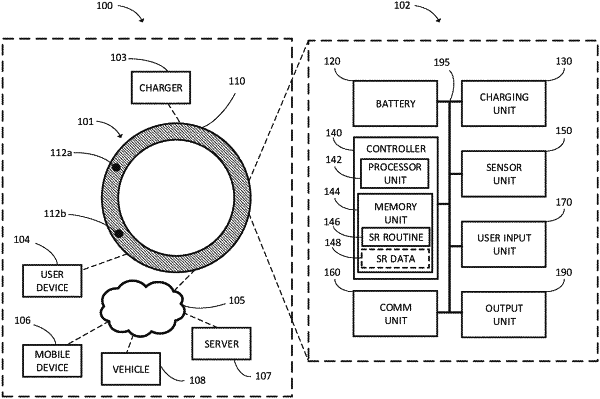| CPC B60W 60/0059 (2020.02) [B60W 40/08 (2013.01); B60W 50/14 (2013.01); B60W 60/0051 (2020.02); G06N 5/04 (2013.01); G06N 20/00 (2019.01); G16H 40/67 (2018.01); G16H 50/20 (2018.01); G16H 50/30 (2018.01); G16H 50/70 (2018.01); H04W 4/12 (2013.01); B60W 2050/146 (2013.01); B60W 2540/229 (2020.02); G06Q 10/10 (2013.01); G06Q 40/08 (2013.01)] | 20 Claims |

|
1. A method for implementing a machine learning model to predict driving risk exposure based at least in part upon observed sleep patterns, the method comprising:
receiving, by one or more processors, one or more sets of first data indicative of one or more sleep patterns collected by one or more sleep monitoring devices;
receiving, by the one or more processors, one or more sets of second data indicative of one or more driving patterns collected by one or more driving monitor devices;
acquiring, via a smart ring associated with a user, a set of user data including data collected by a physiological sensor disposed in the smart ring when the user sleeps;
determining a user sleep pattern based on the set of user data;
predicting, by at least a trained ML model, based on the user sleep pattern, a user driving pattern associated with the user, wherein the trained ML model is trained utilizing the one or more sets of first data indicative of the one or more sleep patterns collected by the one or more sleep monitoring devices and the one or more sets of second data indicative of the one or more driving patterns collected by the one or more driving monitor devices to discover one or more relationships between the one or more sleep patterns and the one or more driving patterns, wherein the one or more relationships includes a relationship representing a correlation between a given sleep pattern and a specific driving pattern, wherein the one or more driving monitor devices includes a vehicle computer or a dedicated electronic driving tracker device, and wherein the one or more sets of second data comprises the one or more sets of second data collected by the vehicle computer or the dedicated electronic driving tracker device;
predicting, by at least the trained ML model, a level of risk exposure for the user during driving based on the user driving pattern;
generating a notification to alert the user of a predicted level of risk exposure wherein the notification includes a suggested remediating action to reduce or eliminate the predicted level of risk exposure; and
analyzing compliance of the user with the suggested remediating action.
|